There are a lot of analogies one can make to compare SNK’s
supergiant The King of Fighters to Capcom’s supergiant Street Fighter. “If
Street Fighter is Chess, King of Fighters is
sumo.” “If Street Fighter is Marvel, King of
Fighters is DC.” The analogy I think is
most accurate is “If Street Fighter is Fist of the North Star, King of
Fighters is Dragonball Z.” I may have already
gone over the main King of Fighters games and why you should absolutely
do whatever it takes to play (most of) them, but for those who want the cliffnotes
version, I have this post.
Because of the length of this article, it will
have to be split into two parts, starting with King of Fighters’ story and
characters. Believe it or not, this one
part is around the same length as the entirety of the Street Fighter camp post. That just goes to show you how
much more story King of Fighters has to it.
Story
The King of Fighters games center around the King of
Fighters tournament, a massive spectator fighting competition where teams of
three (or four, for a few of them) fight until no one on the other team can.
Technically the tournament was somewhat contained at first,
but became a gigantically popular public sport with popularity comparable
to the Olympics by the time of the third game, KOF ’96, which is also coincidentally the first KOF game of any quality.
Every single time a King of Fighters tournament is held, the
fighters get involved with a nefarious force of some kind, almost always trying
to use the tournament for their own evil purposes.
I’ve already detailed
the important bits from the story in my retrospective, but for this more condensed article the
driving forces of the plot will largely be covered when going over the villains. Unlike Street Fighter, which mostly moves on
from one villainous scheme to the next, King of Fighters usually takes two
games for build up, foreshadowing, and establishment before moving on to the
finale in the final game of each of the three main storylines. The bosses in the games before the finale act
as their own climaxes, but not the final ones. In that sense, King of Fighters handles its
story much like the Street Fighter Alpha trilogy.
Heroes
Dear lord this is going to be a long one. With 10 games of story, there have been many
characters that have played the role of the hero at one point or another.
For the first four games, the hero is Kyo
Kusanagi, a cocky, hot-headed, laid back school kid who wields the flames of
Kusanagi, a power his bloodline can use thanks to the Kusanagi sword, one of
the three sacred treasures used to seal off Orochi thousands of years prior by
his ancestor in Japanese legend.
Assisted by his friends, judo gold medalist Goro Daimon
and electric rock star Benimaru Nikaido, Kyo won the first four tournaments and beat the bad guys that showed up in each one, saving the world in the end with the
guardians of the other two sacred treasures.
Though Kyo took the back seat to another hero for the second
storyline, he stuck around and came back in the spotlight as one of the main
focuses during the third. Kyo has been
in every King of Fighters and SNK crossover game since his appearance all the way back in '94, so he's pretty much The
King of Fighter’s mascot.
The hero he took the back seat to in the second storyline is
K’. Always teamed up with his wise, friendly
cyborg partner Maxima, the antisocial K’ is a former member of the evil
organization NESTS, who took his memories from him and possibly implanted new
ones, leaving K’ with a lack of purpose and identity until he gets them back. To that end, K’ fights NESTS from King of
Fighters ’99 to 2001, using his ability to control fire given to him by
implanting a kidnapped Kyo’s DNA.
However, he can only shoot these flames out of his right hand, and
without a special power-constraining glove on it, it burns out of
control.
In a very stark contrast to Kyo, K’ is annoyed by almost
everyone around him and wants to be left alone.
He walks with his hands in his pockets, wears sunglasses, falls asleep
if he stands still in some of the games and doesn’t like doing work (including
fighting). Still, he is a hero, helping others in need,
genuinely caring for his friends (including Kula Diamond, a NESTS refugee with ice
powers he and Maxima have had to look after), and stopping the main villains of
the storyline. He just doesn’t like to
show it, which he of course denies when that's pointed out.
In yet another major departure from traditional heroes, the
alleged hero of the third storyline is Ash Crimson, a mysterious French jerk
who can control his own special green flames.
Throughout the third storyline, Ash plays both sides, working against
and with the heroes and villains, making him an archetypal trickster and wild
card. Many fans questioned why SNK
insisted on naming Ash a hero until the very end, where his true intentions are
revealed.
Because Ash doesn't exactly do the heroes any favors, another
hero appears after his initial appearance to straighten him out. Her name is Elizabeth Blanctorche, a childhood
friend of Ash’s. Both of them were part
of a noble family dedicated to helping the innocent, which Ash Crimson most certainly
is not.
After Ash mysteriously disappeared years before, Elizabeth
caught wind of Ash’s actions in KOF 2003 and enters the following King of Fighters tournaments
to bring him back and explain himself as well as fight the true villains. Eventually she allies
herself with both of Ash’s only known friends, teaming up with one alongside
Benimaru in KOF 11 and replacing Benimaru with Ash’s other friend in 13,
leaving Ash by himself with no team, and a good number of people who want to beat his face in.
Iori Yagami is another plot-important character, but much
less of a hero and more of an anti-hero at best.
Iori is the archetypical rival character to Kyo. He is a descendant of the Yasakanis, who
betrayed the Kusanagis in order to gain some of Orochi’s power, cursing them
all to much shorter lives and half-Orochi blood.
Apparently due to a lasting family grudge against the
Kusanagis, Iori wants nothing more than to defeat Kyo and take down anyone who
gets in his way. His original reason for hating Kyo isn't explicitly clear, but supposedly there's a more in-depth explanation in a KOF comic never released in America.
Iori has an antisocial personality like K’, but he cares far less about doing the right thing, so he doesn’t have any real friends and is much more violent, with heavy use of the word “die” (in Japanese) as he cuts and burns competitors up in brutal ways using the purple flames given to him by his own sacred treasure, the Yasakani Magatama. It’s kind of easy to tell he’s not a straight-up good guy by his slinky movements, drooping clothes and hair, and the belt between his pant ankles and on his neck, possibly symbolizing bondage or restraint. Or just looking cool.
Iori has an antisocial personality like K’, but he cares far less about doing the right thing, so he doesn’t have any real friends and is much more violent, with heavy use of the word “die” (in Japanese) as he cuts and burns competitors up in brutal ways using the purple flames given to him by his own sacred treasure, the Yasakani Magatama. It’s kind of easy to tell he’s not a straight-up good guy by his slinky movements, drooping clothes and hair, and the belt between his pant ankles and on his neck, possibly symbolizing bondage or restraint. Or just looking cool.
Still, he helped save the world. Once.
Though something of a side-hero, there is one other
character that deserves mention: Shingo Yabuki.
Shingo is a silly, clumsy, childish kid from Kyo’s high school who
worships him like Sakura Kasugano worships Ryu. A lot of Shingo's moves are imitations of Kyo’s, which he does mostly right, but without the flames of Kusanagi and with
more falling on his face.
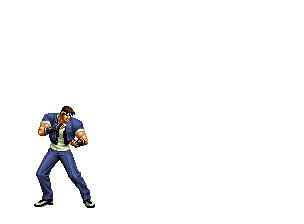 |
| I'm reminded of how Sakura kicks her shoe off when she kicks and the shoe hits her head. |
Shingo was able to enter the ’97 King of Fighters tournament
without a team, but after Kyo gave him his sun-embroidered fingerless gloves,
Shingo has been on a team in every tournament afterwards. Each time save for one, he’s been with
Benimaru, who himself has teamed up with K’, Kyo a couple more times, Goro to
form his own team and Elizabeth. What
particularly marks Shingo as one of the game’s heroes, in addition to his
optimistic personality and good heart, is that he helps the main heroes several times. To me, that makes him a hero too, or at the
very least, a sidekick.
Finally, there’s the other secondary heroes, the Ikari
Warriors, a crack team of badass mercenaries led by the Rolento/Colonel
lookalike Heidern (no first name given), who has alternated between entering the competitions
directly and working from the sidelines.
The two consistent primary members of the Ikari Warriors team are Clark and
…… Sorry.
They are always accompanied by a third and/or fourth member of their organization:
Heidern himself, his adopted daughter Leona (most commonly), and a female
mercenary from another squadron named Whip, who has also joined K’ on more than
one occasion
Whip and Leona actually have fairly important backstories,
but this section is long enough without explaining all that.
The Ikari Warriors team joins the King of Fighters competition
every year to investigate suspicious phenomena (which there always is). Though unimportant in the first
storyline, Heidern and his team play a much bigger role in the ones to follow,
including canonically beating the secondary (anti)villain of KOF 2003. Think of them as the Chun Li & Guile team
of The King of Fighters, only with a living nuclear missile in the form of Ralf.
Villains
If you thought there were a ton of heroes, you may be surprised at the number of villains to oppose them. In the interest of keeping this post under the length of a Harry Potter novel, I will go over some of the villains as groups instead of individually.
The villain of the first two King of Fighters games is Rugal
Bernstein, a ruthless, powerful arms dealer who loves nothing more than fighting worthy opponents. Before the
events of the first game, Rugal killed Heidern’s family and his entire squadron
before ripping the guy’s eye out, all singlehandedly. That’s just how evil Rugal is.
In The King of Fighters ‘94, Rugal planned to cast the KOF
champions in liquid metal to make trophies out of them after he personally beat
them, then in '95, he comes back for revenge with cyborg implants and
using a certain power given to him by another villain.
Think of Rugal as Akuma if he were more moustache-strokingly
evil and had the budget Shadaloo did, allowing him to fund a worldwide
tournament, travel in his own personal aircraft carrier, and have a flying fortress made for his kids. His Batman villain-like resources along with
his intimidating presence and fighting skills make Rugal the franchise’s most
popular villain. He has been repeatedly brought back for the games not involved with KOF’s story,
excluding spin-offs, but including Capcom vs. SNK 2, where he fights with Akuma
and either gives him his Orochi power, or takes his Dark Hadou.
The ones who gave Rugal the power of Orochi in the second game are the
villains of the second storyline known as the Orochi Saga: the Hakkeshu. The Hakkeshu are descendants of a cult of
superpowered beings that serve their serpent god Orochi. Each one represents one of Orochi’s eight
heads, although before the start of the series one member died and another
went rogue. With three more dying at the
end of one of the tournaments, the four left act as the main villains, also
known as The Four Heavenly Kings of Orochi.
The Heavenly Kings’
goal is to energize and reawaken Orochi, first by breaking the seal on him through
killing one of the previous sacred treasure holders, current Yata Mirror holder
Chizuru’s identical sister, then using the fighting spirit in the KOF
tournament to awaken and reincarnate him in the body of one of their own. Once Orochi is back, he plans to destroy all
of humanity for hurting the earth, nature and themselves.
Expectedly, Orochi is the final boss of the Orochi Saga, and
kind of an anticlimactic one because he’s an easier boss than most of the
Hakkeshu. All this time they were
worshipping a god only slightly stronger than Yu Yevon.
It’s important to note though that because Orochi is a god,
he isn’t killed in the end, just sealed away like he was all those years ago.
 |
| Back then we didn't strap our pant legs together. |
The second storyline, known as the NESTS Chronicles, introduces
the titular evil high-tech weapons cartel NESTS. If you thought Rugal had truckloads of money,
NESTS is able to afford a freakin’ space fortress!
 |
| It's no moon. |
NESTS’ main objective overall seems to be to become the most
powerful force in the world through their advanced weapons and their clones of
super-powered individuals infused with Kyo’s fire-giving DNA, such as K’, all alongside clones of Kyo himself.
From King of Fighters ’99 to 2001, NESTS uses the
tournament’s champions for different schemes until their leader is defeated and
their base of operations is wrecked.
Unlike the Heavenly Kings, who use nature’s power such as
wind and fire, NESTS gets their powers from their biological experiments and
technology. For example, Zero, one of
the higher-ups, has a genetically modified black lion to aid him, and lesser
commander Krizalid has a data-encoding suit as well as K’’s fire abilities. NESTS’ leader Igniz also has a special suit
that lets him control bladed tentacles with his mind and has energy
manipulation powers (somehow).
Aside from that, there isn't a whole lot to say about them. I’ll admit, NESTS isn’t exactly the best established group
of villains out there. They kill off
their own employees for little more reason than to show that they’re evil,
there’s apparently a CEO before Igniz that’s never established, and one of their subordinates was even retconned out of the story. Perhaps they would have been expanded upon
better had SNK not gone bankrupt after KOF 2000.
The most recent storyline, the Tales of
Ash, has much better-established and more original villains. The main antagonists of the Tales of Ash are
known only as “Those From the Distant Land,” an organization of ageless
super-beings with their own powers that have existed since ancient times. For the sake of brevity, I often refer to
them as “The Distant Landers.”
Thousands of years ago, The Distant Landers were hailed as
gods for their extraordinary power, apparently bestowed upon them in the same
way the Hakkeshu were given theirs by Orochi.
Back when they were living the high life, being worshipped and getting
what they wanted, their leader, the time-manipulating Saiki, used a monolithic
gate that allowed him to travel to the future, but in the time he was gone, the
humans bit back and almost all of the Distant Landers were killed. Now, in a future ruled by humans, Saiki and
the remaining Distant Landers are trying to power the gate enough to go back far
enough in time to “correct” the problem, helped by the three sacred
treasures they'd bring back from the future to use to control Orochi. To do this, they break the seal of the
Orochi, pinpoint his exact resting place, energize him with fighting spirit from KOF,
harness the power he gives off using special devices connected directly to the
gate, and combine that with the power of a planetary alignment in order to send
Saiki back.
Different members of The Distant Landers have different
views on humans and different powers.
Some like the towering earth-user Mukai and I-swear-that’s-a-girl
Shion think they're foolish, but have potential, while others like the condescending
space manipulator Magaki and Saiki himself find themselves deservedly superior
and consider humans trash.
The strongest of them (the final bosses) also have similar
visual traits. They all have human forms they can change to, and outside of that human form they have white spiky hair and glowing markings over their bodies when using their best attacks.
What’s more, their leader has a very… unique connection to
Ash, giving them a relationship I personally have never seen between a hero and
villain. I’m afraid I can’t spoil just
what that relationship is, however.
Like the heroes, King of Fighters also has some secondary
villains that commit evil deeds in the background. One of the best-known ones is Geese Howard,
the main villain of most of SNK’s Fatal Fury games. Geese has, on more than one occasion, sent
others and even himself to enter the KOF tournaments to investigate the power
that Rugal had in the second game. These
outlaws include his staff-twirling bodyguard Billy Kane, kung-fu hitman Gato,
and Ryuji Yamazaki, the craziest motherfucker in fighting game history, except possibly Guilty Gear’s Faust.
Ryuji is the psycho other psychos hire when they feel
they’re too mentally stable for the job.
He squawks his every death threat line, uses tactics that would
be blatant cheating anywhere else, pretty much bitch slaps his opponent by using
his arm as a whip, and makes very uncouth gestures like foaming at the mouth
and wagging his tongue. He’s anything
but a conventional fighter.
As if you couldn’t get enough of the guy, King of Fighters
2003 introduced players to Rugal’s kids, Adelheid and Rose Bernstein. Taking over their father’s illegal arms
business, Adelheid and Rose live on Sky Noah, a huge flying fortress that
blocks trackers and can’t be seen on radar.
While Adelheid inherited his father’s fighting skills, he’s an honorable
combatant who has even been friendly with Heidern on a couple of occasions in
the story even though he’s a criminal whose father killed Heidern's family. This is especially prominent in the story
mode of King of Fighters 13, despite the fact that Adelheid isn’t even playable
in it.
Rugal’s ruthlessness and pomposity were inherited by Rose,
who can’t fight, but pushes her brother into beating the crap out of other
people. She greatly admires her
brother’s skills (referring to him as “onii-sama”), and everything Adelheid
does is for her, but that doesn’t make him afraid to talk back to her when she
takes things too far.
There is one more secondary villain named Ron, who may not
be so secondary for long. He was once the
leader of a Chinese ninja assassin clan known as the Hizoku, but one day he ravaged the
Hizoku village, killed most of its inhabitants, and ran away to join
NESTS. Two members of the Hizoku who
have joined the KOF tournaments in the past and the government are all looking
for Ron for some answers. Since his
appearance, he has appeared in multiple character endings and has been
referenced many times, but only once has he appeared in battle, assisting one
of NESTS’ higher ups. Currently his true
motives are unknown, but he has shown a strong interest in a special (and
currently vague) power minor character Kensou has called the Dragon Power. See this post for more. He also has some sort of relationship with Saiki that has yet to be fully explored.
The Other Guys
But wait! There’s
more! There are about three times as
many miscellaneous, plot-irrelevant characters as there are important ones, and
like any good fighting game, they all have their own stories to tell.
The majority of these characters are taken from SNK’s other
fighting games, usually Fatal Fury and The Art of Fighting, which always have
their own teams strictly comprised of characters from those series in every
game. The aforementioned Kensou is a
part of the Psycho Soldier team, with him and pop star evil-fighter Athena
Asamiya alongside at least one
other KOF-original character.
Also near-consistently present is the Korean team, also
called the Kim team, led by Fatal Fury tae kwon do master Kim Kaphwan. Kim is a man who strongly believes in justice
and the goodness of man, so throughout the games he forces criminals to join
his team in the KOF competitions as part of a criminal reformation program to
show them sportsmanship and how hard work can lead to appreciation that leads
them to becoming better people, or something like that. It may be that Kim is simply showing them how
their violent tendencies can be used for a better purpose. It’s been acknowledged that it’s kind of a
strange method, but somehow it works.
Since the beginning, Kim has had the tall
and short criminals Chang and Choi on his reformation program, even sharing them with his rival Jhun Hoon to see whose methods are better. After the NESTS Chronicles though, Chang only joins
Kim and Jhun once more before Kim takes in two new criminals in King of
Fighters 13: Fatal Fury’s Raiden and Hwa Jai.
And that’s not even getting into all the other memorable
side characters, like the Mark of the Wolves team, Anti-Kyokugen team, or the
Women’s team. King of Fighters has a ton
of side plots, fleshing out every character excellently, much better
than Street Fighter usually does, in my opinion.
As Iori’s voice actor, Kunihiko Yasui, has stated, SNK
treats their characters as if they were real people, changing them over time through the story’s roster changes, voice clips, special character
introductions, and move sets. Not through age, of course. No one ages!
Though almost always idealized and souped up with godlike
strength and powers, the characters of KOF are much easier to emotionally
connect with because of this presentation as people. They have families, personal issues, and
relationships, which the story of The King of Fighters always takes time to
establish, even if not in the games themselves.
That sense of characterization can also be seen in KOF’s art style
and outfit designs. No matter how
strange a KOF character dresses, it almost always makes sense given their
character’s background. Robert Garcia
changes his clothes several times over the course of the series because he’s
rich, and Athena does it every game because she’s a pop idol, which are
commonly on top of fashion and gives her fans something new. Even Mai Shiranui’s revealing outfit is a
traditional garb from her ninja clan.
The same even goes for Hizoku assassin Duo Lon, whose royalty within the
clan is reflected on his ornate robes.
That’s not to say SNK doesn’t divulge in the fun of
fiction, of course. As much as many of
the designs make sense from a practical standpoint, SNK is never afraid to have
something just because it’s cool. Really, they have something of a reputation for making a lot of "cool" characters, which is part of what separates the visual design from the eccentric Street Fighter cast. They
added Oswald in King of Fighters 11 simply because they needed someone who
looks good in glasses!
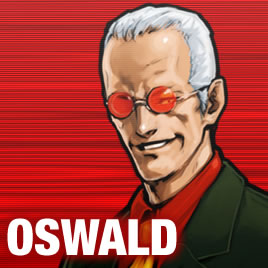 |
| Can't argue with the results. |
This is also seen in the way many characters move in
battle. While several fighters move the
traditional way, keeping their fighting stance as they move and staying
disciplined and stiff, there are several more that move in battle more casually,
like Ash and Shen Woo.
It’s subtle touches and attention to detail like that that
makes SNK able to tell more about a character without words.
And it is my belief each of those characters have a purpose
in mind. While Street
Fighter characters are designed with a general audience in mind (as in, they
appeal to what is generally entertaining for most, which works), I think SNK designs
their characters for specific people.
This is evidenced by characters such as Mexican wrestler Ramon being
designed for their South American players and minor character May Lee being
designed as a “Korean Athena.” The same goes for Maxima, who was made to add another older character to a
franchise filled with teenagers and young adults. SNK knows their audience well, and aims to
make characters for every person in it.
That will become very evident when I go over my fighters of choice, and
it is what makes The King of Fighters characters so special. It’s pandering to the audience in the best
way.
Capcom could learn a thing or two from them. In fact, as we established, they kind of did.
 |
| He counts, right? |



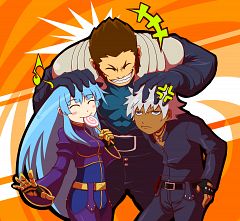
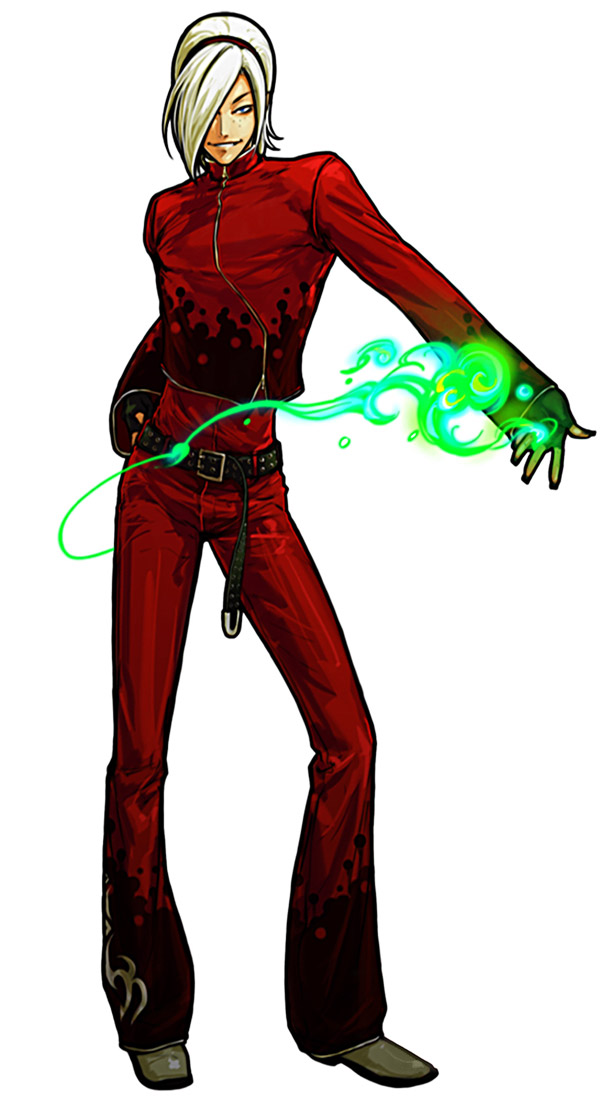

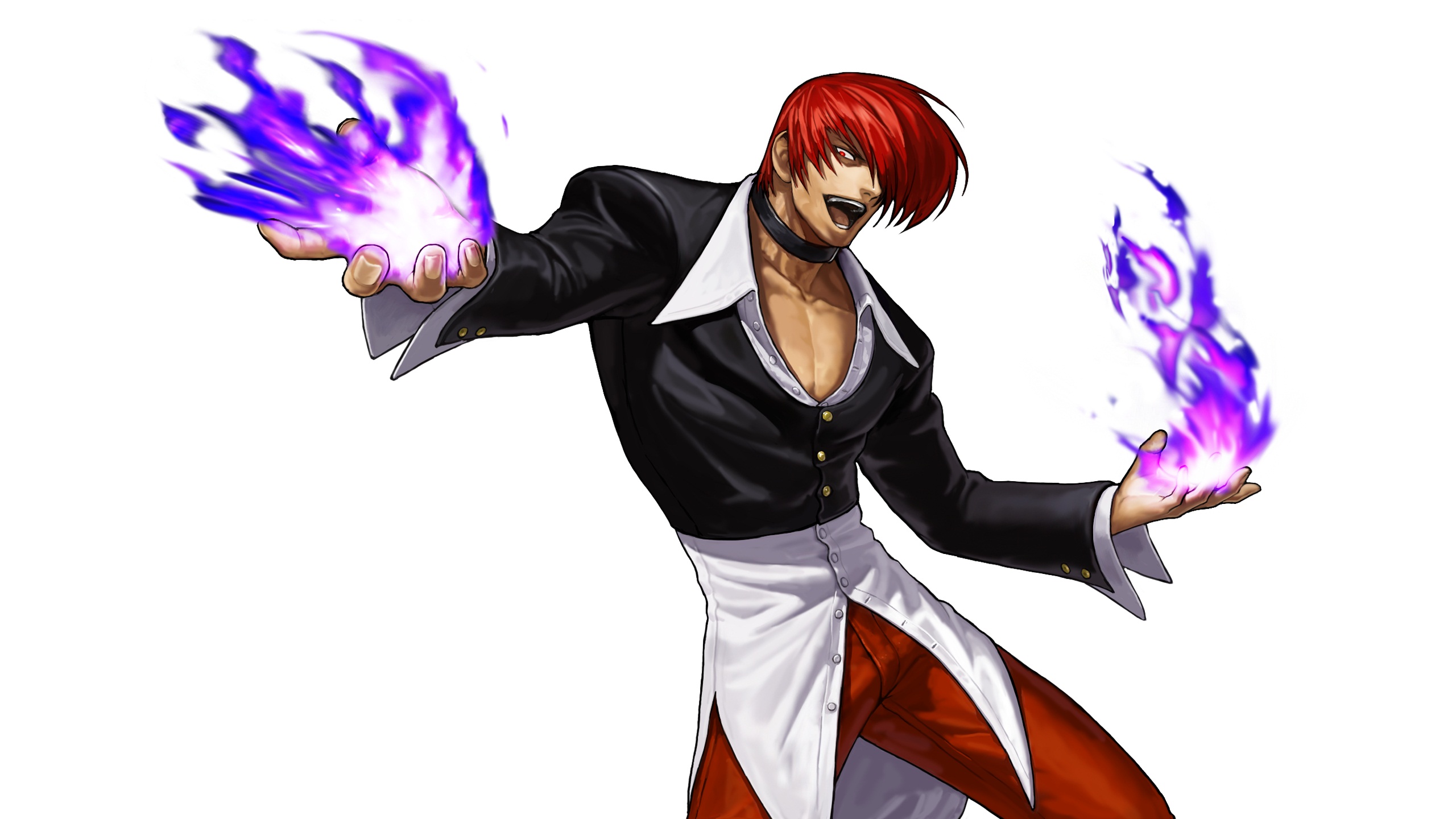





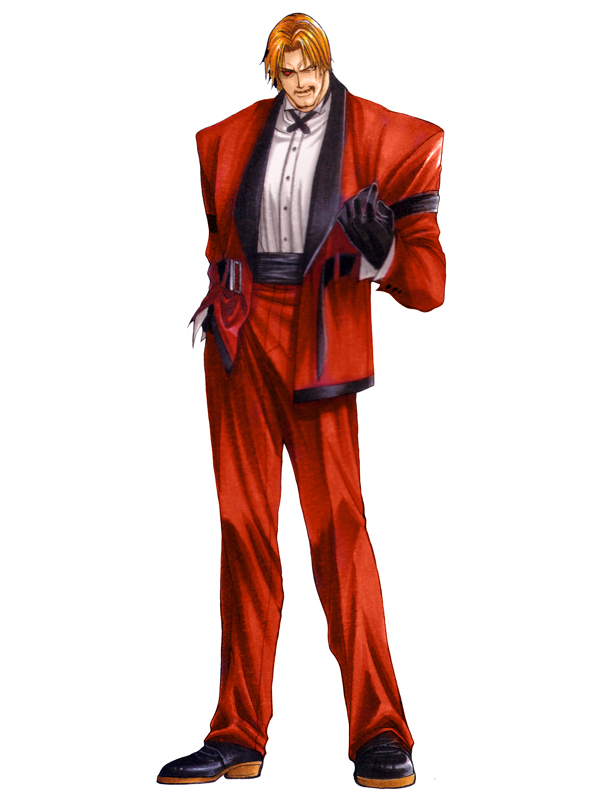


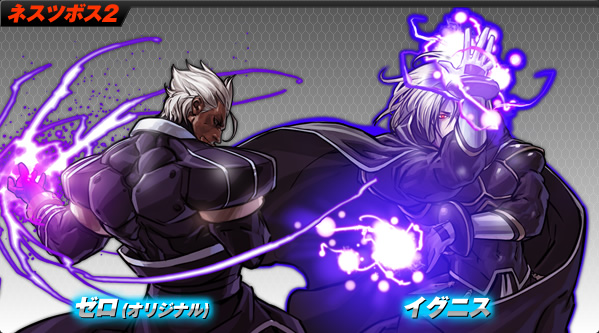





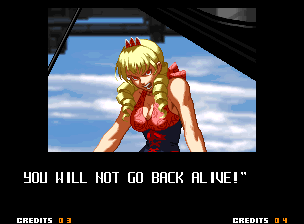

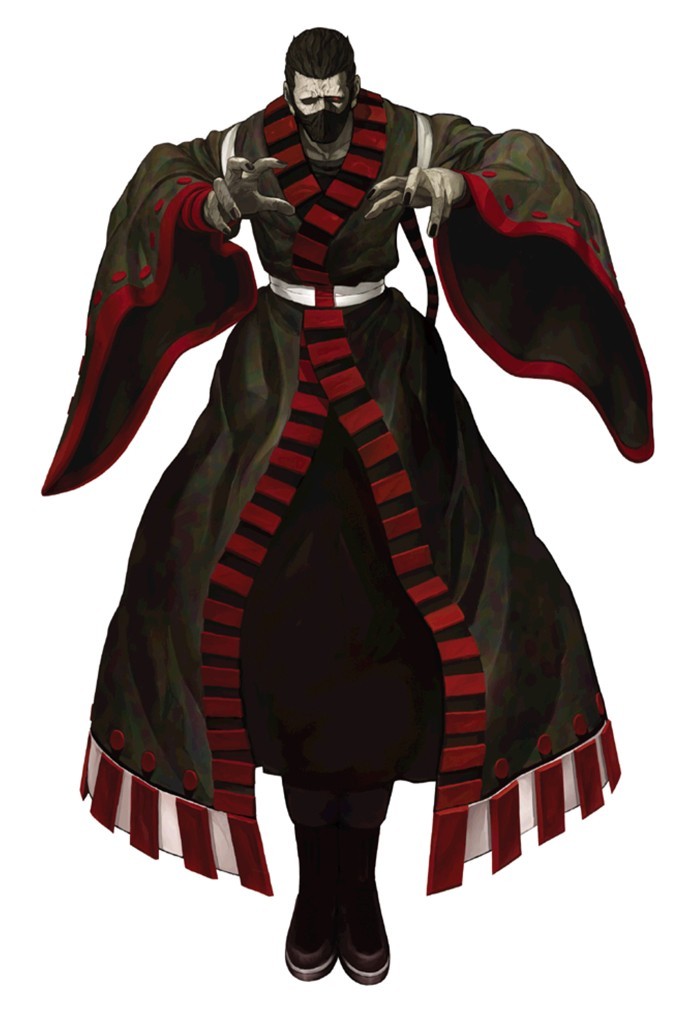





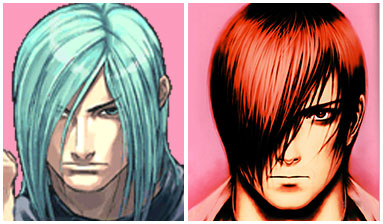
No comments:
Post a Comment